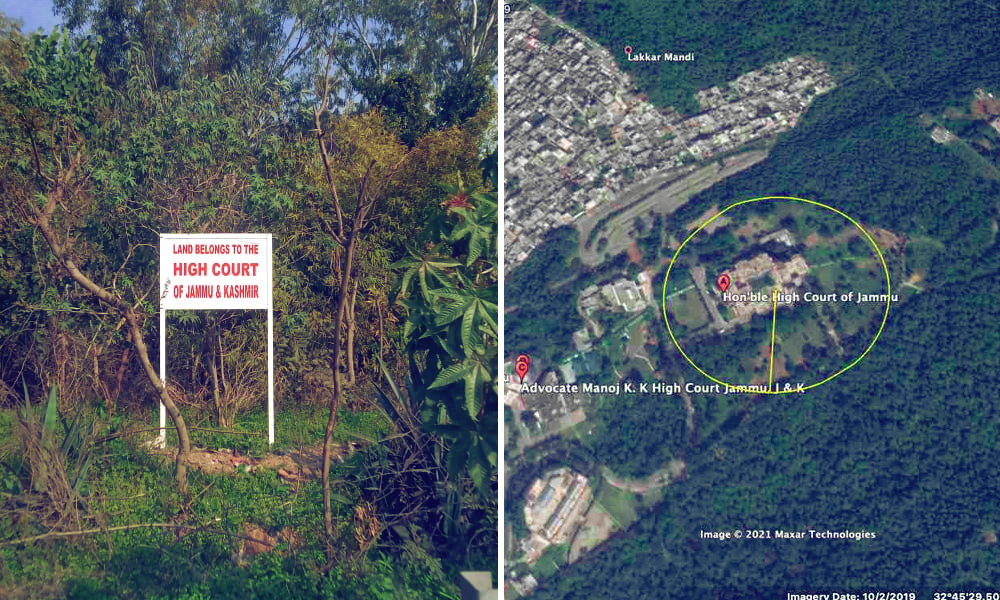
J&K: Official Procedures Rushed, Bypassed To Build New High Court On Protected Forest Land, 38,000 Trees On Line
Jammu and Kashmir, 13 Feb 2021 10:14 AM GMT | Updated 16 Feb 2021 11:33 AM GMT
Editor : Navya Singh |
Navya writes and speaks about matters that often do not come out or doesn’t see daylight. Defense and economy of the country is of special interest to her and a lot of her content revolves around that.
Creatives : Rajath
A free spirit who find meaning in life with the virtue of creativity and doing job par its excellence, animal lover and traveller by heart.
The approval to move the Jammu and Kashmir High Court from the periphery of Jammu city to an ecologically sensitive area has been rubber-stamped despite alternatives.
In October 2019, the Department of Law of Government of Jammu and Kashmir had submitted an indent seeking forest clearance for the construction of a new campus to the government's Principal Chief Conservator of Forests (henceforth PCCF). "It shall be designed as a (sic) eco-friendly campus on principles of sustainability and universal access," the letter read.
The total land required by the user agency was 500 kanals (a traditional unit of the area still used in some parts of the northern Indian states) or equivalent to 25 hectares. Despite enclosing an exhaustive list of facilities to be part of the complex with the specific area requirements for all but a helipad and parking, the High Court body asked for 813 kanals (or 40 hectares) to be cleared inside the Bahu Conservation Reserve.
The matter was dealt with such haste that the proposal passed through eight levels of the chain of command within four days of initial indent submission to be presented in the 117th meeting of the Forest Advisory Committee on October 15.
The Forest Advisory Committee (FAC) gave in-principle approval to the proposal. It was one of the 46 projects on the agenda for that meeting, 45 of which were approved by the committee. That is about one-third of all the projects cleared between August and October that year alone.
According to reports, 3,36,000 kanals of land was identified throughout Jammu for industrial infrastructure development and 1,20,000 kanals in Kashmir in 5 months since the abrogation of Article 370 by the central government.
The State Administrative Council, which comes next in the hierarchy, okayed the use of 40 hectares of forest land, in its meeting a week later, on the condition that the User Agency shall "restrict" the number of trees to be felled to 3,000.
While it was still subject to clearance from the top rung of the ladder—the State Board of Wildlife and the National Board of Wildlife —the entire exercise was carried out under Section 2 of the Jammu and Kashmir Forest (Conservation) Act, 1997. It may be noted that from October 31, the Jammu and Kashmir Reorganisation Act, 2019, was coming into effect which replaced the 1997 Act with provisions of the Indian Forest Act, 1927.
This begs the question: Why were the authorities in question ready to risk the virtual possibility of rejection from the administration whose nod is the basic requirement under section 2 of the Jammu and Kashmir Forest (Conservation) Act, 1997, for the state government to denotify forest land for non-forest use?
But perhaps more importantly, the Housing and Urban Development Department of the Government of J&K (also known as the Jammu Development Authority)—that holds possession of about 59,000 kanals (little under 3,000 hectares) of public land in the UT and manages the planned development of its cities —was not approached by the law department for land requisition, as per the statement of an official in the Jammu Development Authority (JDA).
The Logical Indian spoke to LLB Satyam Arora, a litigant who exhausted all the legal remedies available against the diversion of Raika-Bahu forest land. Arora had first approached the National Green Tribunal Principal Bench.
"The PCCF was directed to produce a 'Factual and Action Taken Report' before the NGT. But our application was dismissed on the grounds that this whole project was passed in accordance with the provisions of law," said Arora.
"So you see, they are admitting (sic) the fact that it is passed under the provisions of Jammu and Kashmir Forest (Conservation) Act, 1997 which only allows denotification of land not exceeding an area 5 acres," he further said.
The review application against the order of dismissal too was rejected leaving the petitioner the only option to approach the Supreme Court. The Special Leave Petition filed in SC against the NGT order met with a similar fate and the locals now officially have no say in whether protected land makes way for the court buildings.
If allowed to go ahead—which could happen any time now—the construction of the new court will take an axe to 38,006 trees falling inside the sanctioned land. Remember, the approval was conditional on restricting the number to 3,000.
1041 of these have a diameter of 30-40 cm or more whose mean age could be 50 years. So, if one were to put a figure on the economic value of the loss of vegetation according to the latest guidelines, the total cost of the large trees when oxygen among other elements is accounted for far exceeds the net present value and the cost of compensatory afforestation combined. We're talking ₹387 crores against the ₹18 crores payable by the user agency.
The existing court complex in Janipur is reportedly spread over an area of 576 kanals. According to an October 2019 report by Daily Excelsior, the original campus has enough space for the expansion the indent sought. Google satellite imagery confirms that there is indeed enough space for expansion to accommodate 35 judges instead of the 17 that the building can hold. The High Court complex would have to compromise on the green space to built-up ratio but the lawns already have a sparse tree population. In contrast, the sanctioned land is categorised as a 'very dense forest' and is ecologically sensitive due to being situated close to the banks of river Tawi.
The report submitted by the office of PCCF states that besides the ongoing Green J&K Drive that aims to plant 50 lakh trees along roads and railway lines, the reorganised state has a forest cover of 48% as compared to the 19.95% of the erstwhile Jammu and Kashmir, and is "substantially higher than" the forest and tree cover of 24.39% at the national level. If that logic is anything to go by, a few hundred thousand Hindu deaths attributable to air pollution every year shouldn't hurt India simply because Hindus make up nearly 80% of the population according to the 2011 census as compared to the pre-Partition estimates of less than 75%.
Documents reviewed by The Logical Indian revealed that the report fulfils its obligation towards biodiversity on the chopping board by disclosing some of the inhabitant faunal species listed as 'least concern' on the IUCN Red List. However, it fails to even acknowledge that the land is cohabited by people of the Gujjar-Bakarwal nomadic tribe.
An interview with Anmol Ohri—founder of the environmental conservation organisation Climate Front India—revealed that as many as 40 houses out of nearly 250 houses fall directly on the project site and are likely to be removed. Varying opinions of the locals on the same have caused confusion among the community, the residents of which are forest-dwellers and have lived there since much before Independence.
Also Read:
 All section
All section














